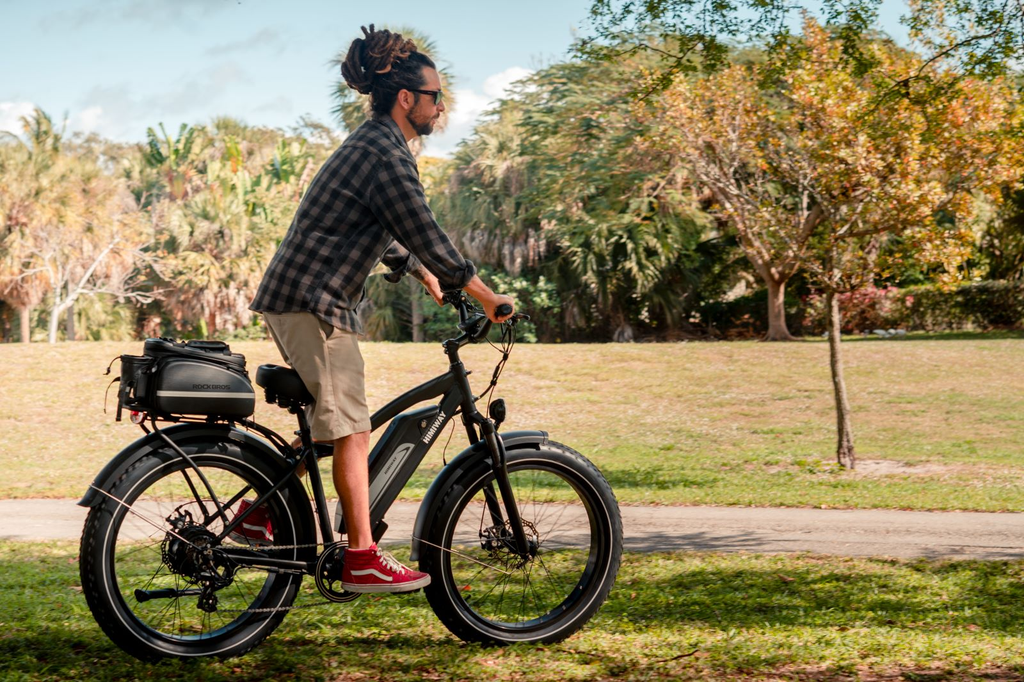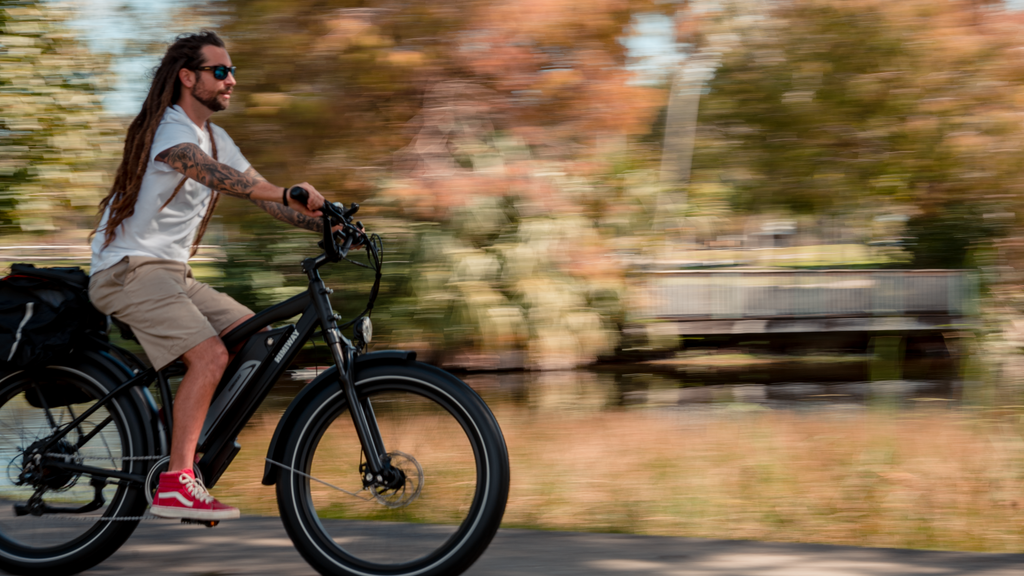Most city dwellers can attest to electric bikes being easier to use, more effective, and more fun for riders of all experience levels thanks to pedal-assist systems with cadence and torque sensors. The pedal-assist system (PAS), which gives riders an additional power surge, is one distinguishing characteristic that sets e-bikes apart from conventional bicycles.
The use of sensors allows a flawless integration of human power and electric help, regardless of whether you select an e-bike with throttle and pedal-assist choices or one that relies on pedal-assist. What the electric bike's cadence sensor and torque sensor do, and the right one to choose between cadence sensor and torque are some topics we will discuss in this article.

Pedal Assist Systems (Pas) And Throttles
Pedal assist is one of the main features of Himiway electric bikes, making pedaling much more effortless. Pedal-assist systems (PAS) will aid riders based on their pedaling input. These systems adjust the motor's power output following your pedaling cadence, force, or both.
By subtly boosting the rider's effort, PAS seeks to mimic the sensation of conventional cycling. A more natural riding experience is provided by the motor's smooth and proportional engagement to the rider's pedaling. Of course, not all rides require you to move at top speed. Therefore, the feature allows you to select the level of pedal assist you want, ranging from level 0 (no assist) to 5 (maximum assist), often offered in various settings or modes depending on your riding experience.
The handlebar-mounted throttle can activate (and occasionally modify) the motor's power output. Since throttles instruct motors to release power without needing pedal motion or input from the user, electric bikes with throttles can move independently. Riders can start the motor with this motor control technique without pedaling. When you open the throttle and activate the engine, your e-bike advances.
Throttles offer a simple control system that is simple to operate. Outdoorsy individuals who love to climb steep inclines or move from a halt without sweat choose bikes with this feature because of the quick acceleration. Also, people with physical limitations, restricted mobility, or those who would instead not pedal far may find it helpful. They provide a choice for those who find it challenging to keep a steady pedaling action.
What Does A Cadence Sensor Do On An Electric Bike
Riders who want to get the most out of their workouts can opt for e-bikes with cadence sensors because it measures if you are pedaling. With the aid of these tools, cyclists can gauge their energy output in terms of revolutions per minute (RPM). Three reasonably compact gadgets that are simple to mount to the bike make up a cadence sensor. One is the electronics pod that mounts to the bike frame. The spoke magnet, and cadence magnet are on either side. The pod has two magnet sensors that can record both cadence and speed.
When riding on or off-road, your overall speed is influenced by the gear you choose and the force of your exertion (heart rate), which determines how quickly or slowly the gears rotate. Measuring cadence with a sensor is crucial for riders who see cycling as more than a simple hobby. Here are more pointers on how the cadence sensor works:
1. As you cycle, the cadence sensor picks up the rotation of the pedals. It provides real-time feedback on your pedaling speed by calculating the number of pedal rotations per minute.
2. The motor controller controls the motor's electric assistance after the cadence sensor has established the pedaling speed.
3. The motor controller modifies the electric motor's power output following information obtained from the cadence sensor. The motor controller maintains the electric assistance.
What Does A Torque Sensor Do On An E-Bike
With innovations unfolding daily, even as experienced riders, there’s a need for further understanding of the e-bike features like the throttle and sensors and how they work. Electric bikes like the Himiway Cobra Electric Mountain Bike with throttle and pedal-assist capabilities typically feature a torque sensor. Regulating the electric motor's output according to the rider's input is essential. Although they provide convenience and control, it's crucial to consider and abide by the local laws in your area that govern e-bikes with throttle and pedal-assist features.
One of the most significant advantages of a torque sensor is its ability to transmit power instantly. This allows Himi riders to operate the motor without pedaling by twisting, pushing a lever, or pressing a button. It’s a convenient feature, especially when starting from a stop, tackling steep inclines, or swiftly accelerating in traffic. Here are more pointers on how your torque sensor works:
1. The torque sensor is responsible for turning on the electric motor without pedaling.
2. It detects the position or movement of the throttle control device, which could be a twist grip, a thumb lever, or a push button. When the rider depresses the throttle, the sensor transmits a signal to the motor controller, which starts the motor.
3. Unlike the pedal-assist system (PAS), which requires pedaling input to engage the motor, the throttle sensor allows riders to access motor power without pedaling. As a result, electric bikes with throttle and pedal-assist options are ideal for people with restricted mobility or physical limitations or who choose not to pedal substantially.
What Level Of Pedal Assist Should I Use When Riding An E-Bike
If you're considering buying an e-bike, one of the first factors to keep in mind is your aim for the bike, as this can determine how much pedal assistance you need to use. Therefore, let's look at the different degrees of pedal assist, how they operate, and which level is best for you on your next ride.
Owing an Himiway electric bike has several benefits, and choosing the one with the right motor power can make a big difference. It can determine the amount of assistance you need to climb up hills and over obstacles and your overall experience riding an e-bike. For instance, your Himiway Zebra Premium All-Terrain Electric Fat Bike has an upgraded motor with 750W power and 86Nm max motor torque.
But the question remains how do these pedal assist levels work? And which pedal assist levels should you go with: the lowest or highest option possible on your e-bike?
Level of Pedal Assist to Use
Using a level one pedal assist is advised if you are new to riding an e-bike and have little cycling expertise. No energy aid is provided while coasting or braking because the motor only activates when you pedal. Additionally, this is a smart option for those uneasy about cycling quickly and uphill. A motor that activates when necessary can also assist you in climbing hills and maintaining your speed if you live in a mountainous area. However, remember that on steep inclines, the motor's output might not propel you back up to speed once it slows naturally; most mid-drive motors feature throttle modes to compensate for power loss.
If you have many years of experience in riding an e-bike, then you can select any time of pedal assist you use. Most experienced riders prefer the level 5 assist, especially on hills, because the assistance levels will tell you how much output the battery or that motor is giving. You can use a level 3 or 4, depending on the hill's incline.
How To Adjust Your E-Bike Pedal Assist
You can adjust your electric bike pedal assist to your preference. What separates the himiway e-bike from others is the ability to customize the number of levels and the amount of power assigned to each level. So follow this process as we guide.
1. You will need to unlock the passcode from the display so we can access its added features. After your bike is on, press the plus and minus buttons for about 2 seconds and enter the passcode zero five one zero.
2. Press the plus and minus buttons after pressing the code the first time. The letter n for the meter menu will appear. If you need to zero out the trip meter, press the plus button once to toggle the display to the letter y.
3. Press I to enter and the trip meter will be reset and sent you back to the display. You need to enter the passcode, so press plus and minus twice to get to the passcode menu.
4. To enter the numbers zero five one zero. You will use the plus button to select the first number, then press I to enter.
5. Since the first number is zero, you only need to press I to enter, which will bring you to the second digit of the passcode.
6. You press the plus sign five times to enter the second digit. After selecting the number five, you must press I again to enter the number and toggle to the third digit.
7. Press plus once to toggle to number one, then press I to enter the numbers and toggle to the last digit zero.
8. Press I to enter to bring up the vol menu. After that, you sill press plus to get to the sca menu. After this menu appears, press I to enter. From here, you can use the plus or minus to scroll up or down respectively through various pedal assist settings.
9. Once you have decided on the number of levels you like, press I to enter, which will bring you to another menu. In this menu, you can assign the percentage of power to each level. When you finish this, press I to return to the sca menu and I again to exit to the main display.
Notes For Adjustment
Each rider can choose how to modify their electric bike's pedal assistance. Here are some crucial considerations and safety procedures for adjustments:
Adapt the pedal assist level to the terrain you'll be riding on
Increasing the assist amount might help simplify pedaling on rugged hills or difficult terrain. On the other hand, to conserve battery life and control better when riding on flat terrain or downhill, you might lower the assist level or turn it off.
Adapt the pedal help to your fitness level and desired training:
The pedal assist can also be adjusted based on your fitness and workout objectives. Lowering the help level or turning it off entirely might put more physical strain on your body and actively work your muscles if you go for a more strenuous workout. A higher assist level might offer a comfortable and smooth experience if you want a more leisurely ride.
Always follow the manufacturer's instructions and guidelines
When modifying your electric bike model's pedal assistance, adhere strictly to Himiway’s guidelines. Sticking to the manufacturer's recommendations for optimum performance and safety is crucial, as each e-bike may have unique suggested settings and restrictions.
Conclusion
Electric bikes often have pedal-assist systems that give riders an extra power boost while still allowing them to experience the thrill of pedaling. These systems ensure the motor assistance is in time with the rider's pedaling effort, whether using a cadence or torque sensor. With no need for pedaling, motor power may be activated using throttle mode, providing quick acceleration and precise control. Terrain, desired workout intensity, battery life, and individual comfort must be considered while adjusting the pedal assist. By being aware of and using them safely, riders can have a safe, unique, and fun experience with electric bikes.















































